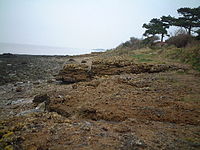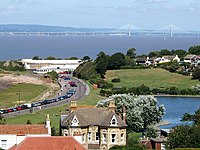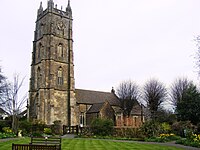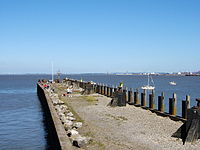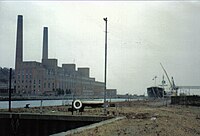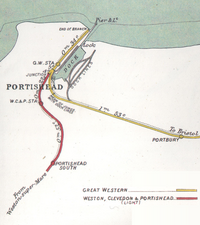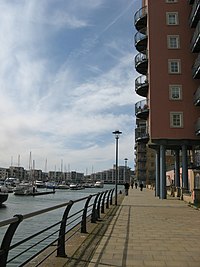Portishead
| Portishead | |
| Somerset | |
|---|---|
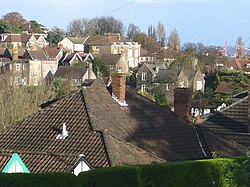 Portishead roofs | |
| Location | |
| Grid reference: | ST470764 |
| Location: | 51°29’2"N, 2°45’45"W |
| Data | |
| Population: | 22,000 (est.) |
| Post town: | Bristol |
| Postcode: | BS20 |
| Dialling code: | 01275 |
| Local Government | |
| Council: | North Somerset |
| Parliamentary constituency: |
Woodspring |
Portishead (pɔːtɪsˈhɛd) is a coastal town of Somerset sitting on the Severn Estuary, between the sea and the Gordano Valley. It has a population of 22,000,[1] an increase of over 3,000 since the 2001,[2] with a growth rate considerably in excess of surrounding towns.[3]
Portishead has a long history as a fishing port. It expanded rapidly during the early 19th century around the docks, with supporting transport infrastructure. A Portishead power station|power station and chemical works were added in the 20th century, but the dock and industrial facilities have since closed and been redeveloped into a marina and residential areas. Portishead was also the telephone control centre used by British Telecom (BT) for non-direct dialled calls to maritime vessels, a service known as Portishead Radio.
The town's population is expanding, and Portishead is now primarily a dormitory town for Bristol and its environs, although a range of service industries has grown up. The headquarters of Avon and Somerset Constabulary are in Portishead.
Contents
Geography
Portishead is on the coast of the Severn Estuary. It lies north west of Clevedon and immediately southwest of Avonmouth, which is just across the River Avon in Gloucestershire. The city of Bristol is 6 miles to the east.
The area immediately inland includes the Gordano Valley, which has been designated as a National Nature Reserve.[4]
Denny Island is a small rocky island of half an acre, with scrub vegetation, approximately three miles north of Portishead and is reckoned to belong to Monmouthshire.
Portishead Pier to Black Nore SSSI is a 177-acre geological Site of Special Scientific Interest notified in 1952. The Portishead Pier Section is made up of alluvial sandstones, the best exposure of Upper Carboniferous rocks in the Avonmouth Coalfield. The cliff and foreshore exposures around Portishead Point provide important exposures of geological structures formed during the Variscan orogeny|mountain building episode in the Carboniferous Period of geological history. Also included are important exposures of the Devonian sequence that yield several species of fossil fish. Holoptychius scales are the most abundant fossils, but teeth scales of other species are also relatively common. Notably amongst the collection from this bed are plates of arthrodires, including Groenlandaspis.[5]
Eastwood and Battery Point Local Nature Reserve is a woodland of 22 acres containing Yew, Maple, Dog's mercury and beech.[6]
The Lake Grounds area, built in the early 20th century around an artificial lake, is the town's main park. Adjacent to the beach and esplanade is a 100 year old artificial lake, and a cricket pitch surrounded by sloping lawns interspersed with specimen trees. One of the UK's few surviving outdoor swimming pools is situated on the shore next to the lake grounds and is open during the summer months. In 2009, the outdoor pool was renovated by a team filming for the American TV programme Ty's Great British Adventure.[7] Above the lake grounds is Battery Point, where a gun battery was sited to protect the Severn Estuary from invasion.[8]
Churches
The Church of St Peter was built in 1320 and rebuilt in the 14th and 15th centuries in the Perpendicular Gothic style. In 1952 it was made a Grade I listed building.[9] The four-stage tower is a prominent landmark, with set back buttresses and a pierced parapet.[9] The church was altered in 1978–1979 and has a new garden developed for the Millennium.[10]
The Chapel of Portishead National Nautical School (now The Fedden Village) in Nore Road, dates from 1911. It is dedicated to St. Nicholas and is also a listed building.[11]
There is also a thriving United Reformed Church [12] which dates from 6 March 1840. One of the early benefactors was Henry Overton Wills of the Wills tobacco family, who were staunch Congregationalists.
History
The name Portishead derives from the "port at the head of the river". It has been called Portshead and Portschute at times in its history and Portesheve in the Domesday Book, and was locally known as Posset.[13]
The town's recorded history dates back to Roman times,[1] although there is also evidence of prehistoric settlement, including polished flint axe heads. There were also Iron Age settlements in the area, of which Cadbury Camp was the largest.[14] Other sites that have been identified include a 1200 ft-by-600 ft site that was successively occupied by the Romans, Britons and Danes.[15] There is some evidence that it may have been the western end of the Wansdyke, an early mediæval or possibly Roman boundary with a series of defensive linear earthworks extending to the Savernake Forest near Marlborough in Wiltshire.[16]
After the Norman Conquest the manor was held by the Bishop of Coutances and later reverted to the crown, after which William II gave it to a merchant from Bristol known as Harding and then to his son Robert Fitzharding who became Lord of Berkeley. The Berkeley family held it for generations until it passed by marriage to the Cokes of Holkham in Norfolk. In the 14th century it belonged to Everard le Frenshe. In 1621 the Bristol Corporation purchased large portions of land in Portishead and revived the Manor Court. The rights of the corporation over the manor was disputed but they held it until 1836 when they sold it for £8,050.[16]
The town was built on the mouth of a small tributary of the Severn Estuary near the mouth of the River Avon. The old pill or jetty provided protection for craft against the Bristol Channel's large tidal range,[14] and iron rings can be seen in the high street at which fishing boats used to moor.[1] Its position meant Portishead was used to guard the "King Road", as the waters around the headland are called. In 1497 it was the departure point for John Cabot on the Matthew for his voyage when he discovered North America.[16] A fort was built on Battery Point,[14] and was used during the Civil War when the town supported the Royalists, but surrendered to Fairfax in 1645.[17][18]
Guns were also placed at Battery Point during Second World War.[14] The King Road was the site of a naval action in 1758 when HMS Antelope captured the Belliqueux, one of a French squadron returning from Quebec.[16]
A mill was built on Welhay stream but this was replaced by tidal mills. In the 17th century the City of Bristol bought the manors of North Weston and Portishead for access to the channel and as a place to stay outside of the city and, in the 19th century, as a seaside resort. An outer sea wall was built allowing the local marshes to be drained and increased the land available for farming.[14] The dominant architecture is early Victorian, with some buildings maintaining their original features.[1] The expansion in residential property coincided with the construction of the dock, pier and the rail link to Bristol.[14] The Royal Hotel by the pier was built in a Tudor Gothic style in 1830,[19] to provide accommodation and catering for travellers on the steamers from Bristol and further afield.
Portishead dock
The Act of Parliament governing the enclosure of Portishead was passed in 1814, and stipulated the right to a public wharf, although there is historical evidence of nautical connections dating back to the Patent Rolls of 1331.[13] Around the 1860s, at the height of the iron and steel era, a pier and a deep-water dock were built by the Bristol & Portishead Pier and Railway to accommodate the large ships that had difficulty in reaching Bristol Harbour.[20][21] They brought valuable cargoes from across the globe and exported local products overseas. Ships carrying coal were commonplace in Portishead Docks.[22]
In the 1880s Portishead Dock was acquired by Bristol Corporation, and was subsequently managed as part of the Port of Bristol until its closure.[23]
Portishead power stations
The Portishead power stations were coal-fed power stations built next to the dock. Construction work started on Portishead "A" power station in 1926. It began generating electricity in 1929 for the Bristol Corporation's Electricity Department.[22][24] In 1937 its original six short chimney stacks were replaced by a 350.0 ft high stack.[24] A second 350.0 ft stack was added when the power station was expanded in 1948.[22]
Construction of Portishead "B" power station began in 1949; it became operational in 1955.[22][24] The power stations became part of the nationalised electricity industry after 1949, and were operated in turn by the British Electricity Authority, the Central Electricity Authority and the CEGB. They used some local coal produced in the Somerset coalfield, which was delivered by train along the Portishead branch of the Great Western Railway (GWR). The line had opened on 12 April 1867 as the Bristol and Portishead Pier and Railway Company; it opened to the dock on 5 July 1879.[20] The main supply of coal was imported by boat from Newport, Monmouthshire and Ely in Gamorgan; it was carried by Osborn & Wallis of Bristol.[25]
Railways
Portishead had two passenger stations on the GWR's Portishead branch line. The main station was near the centre of the village of Portishead, as it was then; the other was at the Pier.[26] The construction of Portishead "B" power station caused the original railway station to be demolished and a replacement station was opened in the High Street on 2 January 1954.[26] The new station closed on 7 September 1964.
The majority of the line was reopened in 2002, to transport freight from the Royal Portbury Dock. A new junction was created, 3 miles from Portishead station, and a new freight line built from there to the Royal Portbury Dock. There is a campaign group aimed at reopening the station and the short stretch of unopened line.[27] In 2009 a report by the Association of Train Operating Companies stated that the Portishead branch was a special case for future consideration of reopening due to the large projected increase in population and congestion in the area.
Portishead also had a second, short-lived, railway line: the Weston, Clevedon and Portishead Railway.[28][29] It ran between Weston-super-Mare and Clevedon as a standard railway line, and between Clevedon and Portishead as a light railway.[29] The Clevedon to Portishead extension opened on 7 August 1907.[29] The line closed on 19 May 1940 and was then dismantled by the GWR.[28][29]
Albright and Wilson
In 1951, Albright and Wilson built a chemical works on the opposite side of the dock from the power stations. The chemical works produced white phosphorus from phosphate rock imported, through the docks, into the UK.[30] Phosphate rock was stored in concrete silos on the dockside until it was required. Electricity provided by the local power stations was used to run six 7.5 MW electric arc furnaces (45 MW total) that reduced the phosphate rock. The phosphorus was then moved in sealed railway tanks to Oldbury and to Kirkby. After the closure of the factory the decontamination included the removal of yellow (spontaneously combustible) and red allotropes of phosphorus.[31] The site is now home to Portishead volunteer coastguard.[32]
Closure of the dock and associated facilities
The onset of new generating capacity at Pembroke (oil-fired) and Didcot (coal-fired) in the mid-1970s brought about the closure of the older, less efficient "A" Station. One generator (500 MW) of four at each of the new power stations had almost the same output of both Portishead Stations combined ("A" Station 200 MW, "B" Station 360 MW).
The newer of the two power stations ("B" Station) was converted to burn oil when the Somerset coalfields closed.[24] The two Radstock pits ceased production in September 1973 and the last train load of coal departed on 16 November 1973. The price of oil rose steeply in the 1970s (see 1973 oil crisis and 1979 oil crisis) and the two power stations were little used after these events.
Portishead "A" power station was closed in 1976; and the first of its two chimney stacks, a landmark, was demolished in September 1981, followed by the second in August 1982.[24] Portishead "B" power station closed in 1982 and both of its 383 feet stacks were demolished in October 1992.[24]
Industrial activities ceased at the dock with the closure of the power stations. The Port of Bristol Authority finally closed the dock in 1992.[33]
Redevelopment of the docks
The harbour area has been developed to provide a marina. The area of the town formerly occupied by the two power stations has also been redeveloped to provide a wide range of housing, from social housing to more expensive apartments. Development is also underway on the Portbury Ashlands to the east of the harbour (so-called because they were the dumping ground for power station waste) extending the area of the town further towards Portbury.[34]
One of the major changes that has shaped the town's rapid development is the conversion of a traditional deep-water dock into a new marina housing some 245 yachts and cabin cruisers.[35] The original dock enabled ships to supply coal to the two adjacent power stations. Since then the marina has become a waterfront development known as Port Marine, incorporating an area built in the style of a fishing village, which is modelled on the Cornish seaside town of Polperro with narrow streets and multi-coloured houses. New waterside bars and restaurants have opened, and further shops, pubs and restaurants are scheduled to open in the future.[36]
Portishead Radio
Portishead was previously the telephone control centre used by British Telecom (BT) for non-direct dialled calls to maritime vessels, a service known as "Portishead Radio". This has now been largely replaced by INMARSAT, which permits directly dialled calls made from any BT landline in the UK. The radio station had separate transmitting and receiving stations.[37] They were constructed by the Marconi Wireless Telegraph Company and operated by the General Post Office (GPO). By 1936, the station had a staff of 60 radio officers who handled over 3 million words of radio traffic per year.[38] Following the privatisation of the GPO's telephone network in 1981, the station was operated by British Telecommunications PLC (now known as BT Group PLC). The main transmitting station, which was remotely operated, originally consisted of a large array of radio masts at nearby Portishead Downs but was replaced by a single radio mast at Clevedon. It was used until the 1970s.[37] The receiving station's control centre and radio masts were located at Highbridge, near Burnham-on-Sea.[37]
The radio station played a vital role during Second World War in maintaining communications with the British merchant navy and with patrol aircraft in the North Atlantic. During the war, all communications with ships were one-way in order to avoid revealing the ships' locations to the enemy. The station was short-staffed because many were on secondments to various government services, such as operating other radio stations and training new radio officers to work in naval convoys. In 1943, the workload was so great that a Royal Navy officer and 18 telegraphists were brought in from HMS Flowerdown]], a Naval Shore Wireless Service station near Winchester.[38]
By the end of the 1980s, satellite communications had started to take an increasing share of the station's business, and a programme of severe rationalisation began, leading to the closure of two transmitting sites at Leafield and Ongar. In the radio station's penultimate year to March 1999, there were on average, per month, 571 radio telegrams, 533 radio telephone calls, and 4,001 radio telex calls. In 1998, British Telecom Maritime Radio Services announced its planned closure of Portishead Radio. The long-range services (HF bands 3–30 MHz) ceased at midnight on 31 August 1999. The short-range VHF maritime band services (156–174 MHz) closed at 12:00 on Sunday 30 April 2000, and the medium-range services (MF maritime band 1.6–3.0 MHz) at 12:00 on Friday 30 June. The station closed in April 2000.[38] The Highbridge station has been demolished.
Culture
There are various groups and societies in the town, including the Gordano society that is involved in history, conservation, environment, planning and wildlife issues,[39] a horticultural society,[40] and the Portishead Railway Group that is campaigning for the Portishead to Bristol railway line to be re-opened.[41] There are also church and youth organisations such as the Portishead Youth Club,[42] a choral society,[43] which was formed in 1955,[44] and an annual carnival.[45]
A public art programme started in 1999 from the marina development, as part of a planning agreement]] between the developers the local council, resulting in the usualk collection of odd, box-ticking sculpture.[46][47] An art trail takes in 28 public art works around the marina and Ashlands development.[48]
Outside links
| ("Wikimedia Commons" has material about Portishead) |
References
- ↑ 1.0 1.1 1.2 1.3 "About Portishead". Portishead and North Weston Town Council. http://www.portishead.gov.uk/About_Portishead.aspx. Retrieved 1 December 2009.
- ↑ "Parish of Portishead and North Weston". 2001 Census Parish Information Sheet. North Somerset Council. http://www.n-somerset.gov.uk/NR/rdonlyres/E9B6D4EF-7C60-4B5E-8937-9E84182D8F89/0/census_PortisheaAndNWestonParishCensusInfo2001.pdf. Retrieved 8 August 2009.
- ↑ "Portishead bucks trend as new stores open". Bristol Evening Post (This is Bristol). 9 October 2009. http://www.thisisbristol.co.uk/Portishead-bucks-trend-new-stores-open/story-11237925-detail/story.html. Retrieved 6 June 2012.
- ↑ "Gordano Valley NNR". Natural England. http://www.naturalengland.org.uk/ourwork/conservation/designatedareas/nnr/1006061.aspx. Retrieved 31 January 2010.
- ↑ English Nature citation sheet for the site (Retrieved 13 July 2006)
- ↑ "Landscape and Nature Conservation". Severn Estuary Coastal Group. http://www.severnestuary.net/secg/docs/6.14.pdf. Retrieved 2 December 2009.
- ↑ "Turn out to welcome Ty to Portishead pool". Bristol Evening Post. This is Bristol. 13 June 2009. http://www.thisisbristol.co.uk/homepage/Turn-welcome-Ty-Portishead-poolarticle-985599-details/article.html. Retrieved 1 December 2009.
- ↑ Crowhurst, page 82.
- ↑ 9.0 9.1 National Heritage List 11136751: Church of St Peter
- ↑ "St Peter, Portishead". Church of England. http://www.achurchnearyou.com/portishead-st-peter/. Retrieved 8 April 2009.
- ↑ "Chapel at Portishead National Nautical School". Images of England. English Heritage. http://www.imagesofengland.org.uk/Details/Default.aspx?id=459874. Retrieved 1 December 2009.
- ↑ "Portishead United Reformed Church". http://www.portisheadurc.co.uk/?data=hMVN%2FbkIDSUhwoy%2Fvnaeww%3D%3D. Retrieved 17 March 2010.
- ↑ 13.0 13.1 Farr, Grahame (1954). Somerset Harbours. London: Christopher Johnson. pp. 49.
- ↑ 14.0 14.1 14.2 14.3 14.4 14.5 "Portishead History". Guide2 Portishead. http://www.guide2portishead.co.uk/client/PortisheadHistory.htm. Retrieved 17 March 2010.
- ↑ "Portishead". GENUKI. http://www.genuki.org.uk/big/eng/SOM/Portishead/. Retrieved 3 December 2009.
- ↑ 16.0 16.1 16.2 16.3 Robinson, W.J. (1915). West Country Churches. Bristol: Bristol Times and Mirror Ltd. pp. 115–119.
- ↑ Lewis, Samuel (1848). "Portishead (St. Peter)". 'Poolton – Portishead', A Topographical Dictionary of England. British History Online. pp. 593–596. http://www.british-history.ac.uk/report.aspx?compid=51219#s25. Retrieved 17 March 2010.
- ↑ Newman, Paul (1976). Channel Passage. Kingsmead Press. pp. 2. ISBN 901571741.
- ↑ "The Royal Hotel". Images of England. English Heritage. http://www.imagesofengland.org.uk/Details/Default.aspx?id=394090. Retrieved 17 March 2010.
- ↑ 20.0 20.1 Awdry, page 19
- ↑ Smith page 96
- ↑ 22.0 22.1 22.2 22.3 Winter pages106-113
- ↑ Elkin, P. W. "Aspects of the recent development of the port of Bristol". AHDS. http://ads.ahds.ac.uk/catalogue/adsdata/cbaresrep/pdf/074/07404001.pdf. Retrieved 26 February 2010.
- ↑ 24.0 24.1 24.2 24.3 24.4 24.5 Crowhurst, pages 62–66.
- ↑ Winter pages177-180
- ↑ 26.0 26.1 Crowhurst, pages 45–50
- ↑ "Portishead Railway Group". Portishead Railway Group. http://www.portisheadrailwaygroup.org/. Retrieved 1 December 2009.
- ↑ 28.0 28.1 Crowhurst, pages 51–56.
- ↑ 29.0 29.1 29.2 29.3 Awdry, page 242
- ↑ "Albright and Wilson Ltd". ICI. 1960. http://www.catalyst.org.uk/download/Historical/Albright%20and%20WIlson%20competitive%20analysis%20by%20ICI%20in%201960.pdf. Retrieved 3 December 2009.
- ↑ "Decontamination and Remediation Works at Albright & Wilson, Portishead". IDS Environment. http://www.ids-environment.com/environment/us/whitepaper_contaminated_land/43/paper_information.html. Retrieved 3 December 2009.
- ↑ "Portishead HM Coastguard". Guide to Portishead. http://www.guide2portishead.co.uk/client/portishead_hm_coastguard.htm. Retrieved 3 December 2009.
- ↑ "City of Bristol (Portishead Docks) Act". Office of Public Sector Information. 1992. http://www.opsi.gov.uk/Acts/localact1992/ukla_19920021_en_1. Retrieved 1 December 2009.
- ↑ "Ashlands, Portishead Brownfield Regeneration, Earthworks and Infrastructure Design". Supporta. http://www.supportaps.com/files/Ashlands,%20Portishead.pdf. Retrieved 17 March 2010.
- ↑ "Portishaed Quays". Quay Marinas. http://www.quaymarinas.com/marinas/portishead.asp?q=portishead&s=2. Retrieved 14 February 2010.
- ↑ "Port Marine". Port Marine. http://www.port-marine.co.uk/. Retrieved 14 February 2010.
- ↑ 37.0 37.1 37.2 Crowhurst, page 78.
- ↑ 38.0 38.1 38.2 Bennett, Larry; Brian Lea. "The Story of Portishead Radio" (PDF). Portishead Radio -GKA. Larry Bennett. http://www.portishead-small-boat-sac.co.uk/bpd.pdf. Retrieved 25 November 2012.
- ↑ "The Gordano Society". The Gordano Society. http://www.gordanosociety.org.uk/. Retrieved 17 March 2010.
- ↑ "Portishead Horticultural Society". Portishead Horticultural Society. http://www.portisheadhorticultural.org.uk/. Retrieved 17 March 2010.
- ↑ "Portishead Railway Group". Portishead Railway Group. http://www.portisheadrailwaygroup.org/. Retrieved 17 March 2010.
- ↑ "Portishead Youth Centre". Portishead Youth Centre. http://www.portisheadyouthclub.co.uk/. Retrieved 17 March 2010.
- ↑ "Guide2 Portishead". Guide2 Portishead. http://www.guide2portishead.co.uk/. Retrieved 17 March 2010.
- ↑ "History of the Society". Portishead Choral Society. http://www.portisheadchoral.co.uk/history.html. Retrieved 11 November 2010.
- ↑ "Portishead Carnival". Guide2 Portishead. http://www.guide2portishead.co.uk/client/Portishead%20Carnival.htm. Retrieved 17 March 2010.
- ↑ "public art story". Public Art — Port Marine. http://www.publicartportishead.co.uk/simple.cfm?page_id=144&cfid=14208639&cftoken=27446688. Retrieved 12 May 2011.
- ↑ "Public Art: A Guide". Public Art — Port Marine. 2009. http://www.publicartportishead.co.uk/cmfiles/154/Portishead_Brochure.pdf. Retrieved 12 May 2011.
- ↑ "port marine, portishead — public art map". Public Art — Port Marine. 2009. http://www.publicartportishead.co.uk/Trail_Map_09_AW.pdf. Retrieved 12 May 2011.
Books
- Awdry, Christopher (1990). Encyclopaedia of British Railway Companies. Patrick Stephens Ltd. ISBN 978-1-85260-049-5.
- Crowhurst, Ken (2001). Images of England: Portishead. Stroud: Tempus Publishing/The History Press Ltd. ISBN 978-0-7524-2240-4.
- Smith, Martin (1992). The Railways of Bristol & Somerset. Sherton: Ian Allan Publishing. ISBN 978-0-7110-2063-4.
- Winter, Michael T. (2005). The Portishead Coal Boats: A History of Osborn & Wallis Ltd, Bristol. Lydney: Black Dwarf Publications. ISBN 978-1-903599-13-6.
